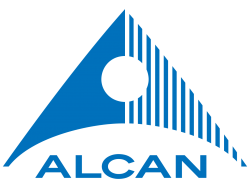Difference between revisions of "Alcan"
(logo) |
|||
| Line 1: | Line 1: | ||
{{group | {{group | ||
|start=1902 | |start=1902 | ||
| + | |logo=Alcan.png | ||
|wikipedia=https://en.wikipedia.org/wiki/Alcan | |wikipedia=https://en.wikipedia.org/wiki/Alcan | ||
|type=commercial | |type=commercial | ||
|successors=Rio Tinto Alcan | |successors=Rio Tinto Alcan | ||
}} | }} | ||
| − | [[Alcan]] was a Canadian aluminium company, formed in 1902 and one of the earliest large al co's. Its | + | [[Alcan]] was a Canadian aluminium company, formed in 1902 and one of the earliest large al co's. Its UK subsidiary, [[British Alcan]], owned a number of facilities in the UK which were (and probably still are) important in supplying aluminium for the Ministry of Defence<ref>Das, S. and Padel, F. 2010,'Out of this earth: East India Adivasis and the aluminium cartel' Orient Blackswan </ref>. |
In 2008 it was merged with [[Rio Tinto]] to become [[Rio Tinto Alcan]], the world's largest aluminium producer. | In 2008 it was merged with [[Rio Tinto]] to become [[Rio Tinto Alcan]], the world's largest aluminium producer. | ||
Latest revision as of 15:03, 26 June 2016
 | |
| Successor | Rio Tinto Alcan |
| Formation | 1902 |
| Type | commercial |
Alcan was a Canadian aluminium company, formed in 1902 and one of the earliest large al co's. Its UK subsidiary, British Alcan, owned a number of facilities in the UK which were (and probably still are) important in supplying aluminium for the Ministry of Defence[1].
In 2008 it was merged with Rio Tinto to become Rio Tinto Alcan, the world's largest aluminium producer.
Alcan't in South Africa
Alcan's plans to build a $2.7 Billion aluminium smelter at Coega, near Port Elizabeth South Africa. The development has sparked large scale local protest as it has caused price rises and electricity blackouts for resident's already in poverty, as it is demanding too much power from the grid, and paying such low prices for energy that the taxpayer is at times actually subsidising it[2]. “Thirty percent of the poor communities of South Africa don’t have electricity, and now that will be going straight to Alcan,” says Lerato Maregele, a S-African activist, quoted in Icelandic newspaper 'Reykjavik Grapevine'[3]
The local campaign group Alcan't in South Africa also note that Alcan received sustained pressure from social justice groups in Canada over its investments in South Africa during apartheid. Alcan had 24% shares in Hulett Aluminium which manufactured military equipment and according to The Task Force on the Churches and Corporate Responsibility (TFCCR), contributed to the South African apartheid government’s armed repression. Alcan sold its share in 1986 following international pressure[4]
'Cultural Genocide' in Kashipur, India
Das and Padel accuse Alcan of promoting cultural genocide in Kashipur where they are were involved in a large bauxite mine[5]. Mining and dams have already displaced 150,000 mainly tribal people there[6]. Alcan stepped into the deal in 2000 after Norsk Hydro pulled out following a police firing on local protesters that killed three and injured seven. They sold their 45% stake again in 2007 under pressure from international campaigns[7].
References
- ↑ Das, S. and Padel, F. 2010,'Out of this earth: East India Adivasis and the aluminium cartel' Orient Blackswan
- ↑ Environment SA. 11 May 2007 COEGA ELECTRICITY - WHO WILL PAY? Accessed 16/05/10
- ↑ Grapevine, Issue 10, July 13, 2007 Saving Iceland summer 2007 Accessed 15/07/10
- ↑ Alcan’t website, Alcan History in South Africa Accessed 15/07/10
- ↑ S. Das & F. Padel, Economic and Political Weekly, Dec. 2005 Double Death – Aluminium’s Links with Genocide Accessed 15/07/10
- ↑ Chandra Siddan, “Blood and Bauxite”, Montreal Mirror, Nov 20-26, 2003, Vol. 19 No. 23
- ↑ Business Line, July 19, 2007 Hindalco buying Alcan’s 45% stake in Utkal Alumina Accessed 15/07/10